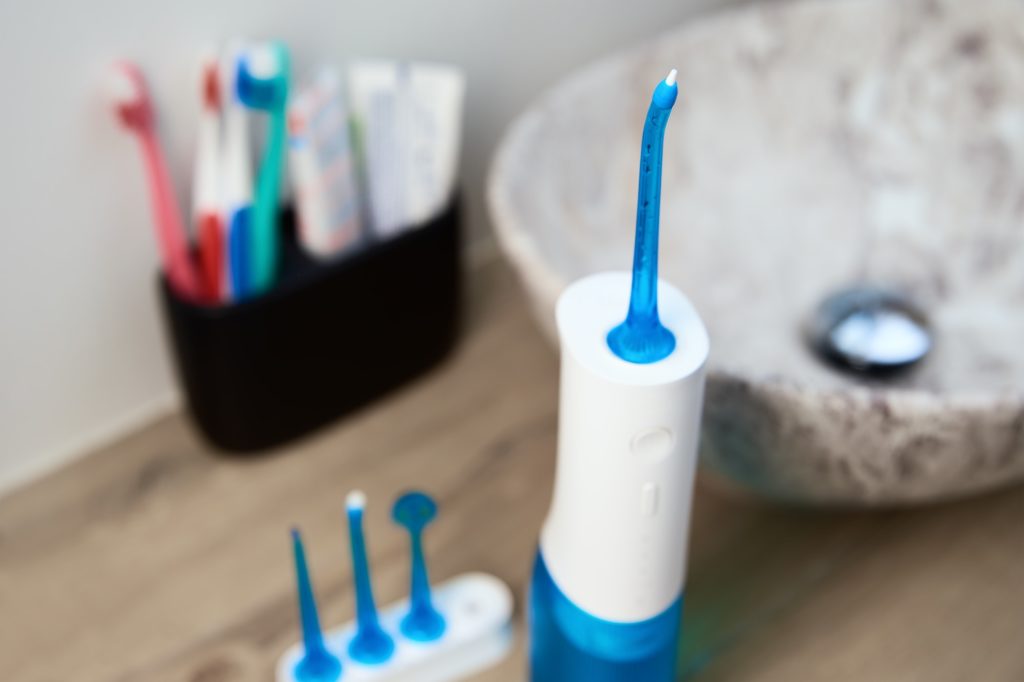Waterpik vs. Flossing: Which Is More Effective for Oral Health?

Everyone wants to have a pearly white smile, but keeping and maintaining that smile takes a lot of work. Forgetting to practice good dental hygiene can cause all sorts of problems —from cavities to tooth extractions to some forms of gum disease, there are all sorts of pesky issues that can surface from not cleaning your teeth properly. Luckily for you, there are plenty of great tools to help keep your teeth feeling good, and looking white, bright, and nice — like classic floss or the more modern Waterpik.
Table of Contents
What is Dental Floss?
Ahhh dental floss, the tried and true classic. Floss has actually been around since 1815! It was invented by a dentist who wanted something thin to clean between his patient’s teeth, and that’s exactly what it’s still used for today. How to floss: take your floss and cut a two-foot string. Then wrap some floss around both of your pointer fingers, creating a tight line of floss. Slide the floss in between your teeth, going up to the gum and then back down along the sides. Do this to each side of the tooth and then repeat on all your other teeth. Even if you have braces it is important to floss — here are a few tips on how to floss with braces properly.
Floss today is still one of the best tools for preventing gum disease (no wonder your dentist always berates you to do it every day!) floss helps get rid of bacteria, plaque, and food particles. Floss is also great for removing plaque since you can wipe each tooth clean of all the plaque stuck on your teeth before it hardens and turns into tartar.
One thing you have to be careful about when using floss is making sure not to apply too much pressure to your gums. Flossing too hard around the gum line can cause them to bleed and become inflamed.
What is the Waterpik?
The Waterpik is a great tool to show how dental technology and tools have advanced through the years. Waterpiks (water flossers) are tools that do a similar job to what floss does. It uses pressure to shoot out water at your teeth, cleaning and removing food particles away from your teeth and gums. Waterpiks are great tools for cleaning when you may have complications going on in your mouth. Things like braces, dental implants, or post-wisdom tooth surgery may make it hard to floss, so the Waterpik makes a great option for cleaning your teeth in nearly any situation. Using a Waterpik is great for those hard-to-reach areas of the mouth and periodontal pockets. A big plus is that the Waterpik is easy to use.
Dentists recommended starting by cleaning the back teeth and working up to your front teeth. You will need to clean both the inside and outside and upper and lower teeth to ensure top cleanliness. In the beginning, you’ll have some testing to figure out which setting is best for you. Things like the power settings and the temperature of the water will all be up to your personal preference. For the best results, make sure you place the tip of the Waterpik in your mouth so you are close to your teeth and gums.
Now that you know and understand each tool, let’s look at the pros and cons of each.
What are the Pros and Cons of Using Floss?
Floss Pros
- Easy to control where you clean
- Ability to clean a full tooth at once
- Affordability
- Very good at removing plaque
Floss Cons
- Unable to reach some areas in the back of your mouth
- Can cause your gums to bleed
- Incorrectly flossing will not improve dental hygiene, and can harm or damage your gums
What are the Pros and Cons of Using a Waterpik?
Waterpik Pros
- Very easy to use
- Ability to clean hard-to-reach areas
- Cleans tight spaces
Waterpik Cons
- Not the best for plaque removal
- Can be expensive
- Messy
Waterpik & Dental Floss FAQs
A Waterpik, a water flosser, is typically used as part of your oral hygiene routine to clean between your teeth and along the gumline. It benefits individuals with braces, dental implants, or hard-to-reach areas where traditional flossing may be challenging.
You can use a Waterpik in addition to regular brushing and flossing to help remove plaque and food debris, promoting better oral health and reducing the risk of gum disease and cavities. It’s a versatile tool that can benefit people of all ages. Still, following your dentist’s or dental hygienist’s recommendations for its specific usage in your oral care routine is essential.
Dental floss should be used daily as part of your oral hygiene routine, typically before or after brushing your teeth. Its primary purpose is to clean the tight spaces between your teeth and along the gum line, where a toothbrush may not reach effectively. By flossing regularly, you can remove plaque, food particles, and bacteria from these areas, helping to prevent gum disease, cavities, and bad breath.
Flossing before brushing can also make it easier for toothpaste to reach and clean these interdental spaces. Consulting your dentist or dental hygienist for proper flossing techniques and recommendations tailored to your specific dental needs is advisable.
It is generally recommended to brush before flossing. Brushing first helps remove loose debris and bacteria from the surface of your teeth, making it easier for the dental floss to access and clean the spaces between your teeth and along the gumline. Flossing after brushing allows you to dislodge and remove particles and plaque from these hard-to-reach areas, ensuring a more thorough cleaning and better oral hygiene.
However, the most important thing is to consistently brush and floss daily, regardless of the order, as both are essential components of a comprehensive oral care routine.
A Waterpik can effectively remove debris and promote gum health, but it may not be a complete replacement for dental floss. While a Waterpik uses water to clean between teeth and along the gum line, dental floss physically removes plaque and food particles by scraping them off. Flossing can be more precise in tight spaces.
Ideally, using both a Waterpik and dental floss in your oral care routine can provide comprehensive cleaning, but the choice between them often depends on individual preferences and dental needs. Consulting with your dentist or dental hygienist can help you determine the best approach for your situation.
